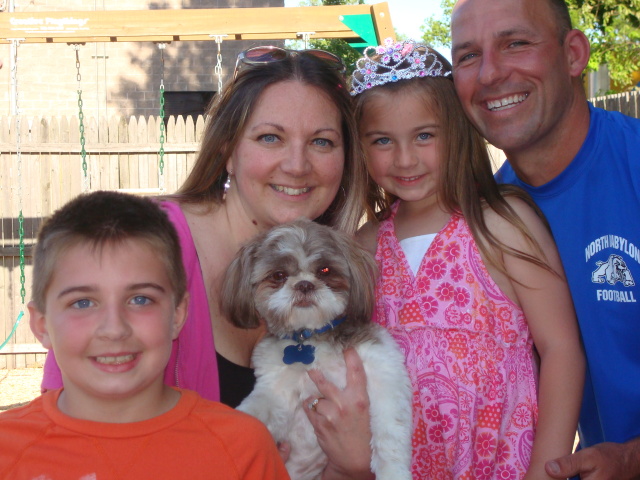QuestionI have a 2 year old Yorkie/Terrier mix female that has never been bred or spayed. She has been in heat three times, the most recent about 2 months ago. She has just recently (within the past 2 weeks) begun "humping" on our legs when we play with her. She stops when scolded, but begins again when we begin playing again. Why this sudden change in behavior? She has never done this before. And what can we do to help her stop?
AnswerHi Lindy,
Thanks for sending me a question at AllExperts!
There may be any number of reasons why your unspayed female is humping your leg. First, you say that she only does this when you play with her. Some dogs, even females, when they become overaroused by high level activity, such as intense playing, may exhibit this behaviour to some degree.
You may be seeing the behaviour now because sexual hormones may be influencing her behaviour. Other contributing factors could be anxiety, a response to stress, a new male dog on the premises or in a home or apartment nearby, and sometimes the mounting/humping can even be a dominance behaviour with some dogs.
Certain medications and medical conditions may also cause the humping behavior, such as corticosteroids like prednisone, but you didn't mention whether your female Yorkie/terrier X is on any medications. Hypothyroidism can also sometimes cause the behaviour, and although hypothyroidism is rare in dogs (more common in cats) and your dog is on the young side to have hypothyroidism, it may be one of the possibilities if there is no other explanation - but if this were my dog I would consider these last resorts of possibilities.
Sometimes dogs mount as part of an obsessive compulsive disorder (OCD). In some cases where the behaviour is due to an OCD, ramping up the dog (as in playing) may create an adrenaline rush in the dog's brain and cause OCD behaviours to be more apparent and frequent as a by-product of the extra adrenaline. See if you can keep the playing a little more low-key, with frequent breaks BEFORE your dog exhibits the humping behaviour and before you see her getting really ramped up and aroused, and then resume playing after a two minute break and repeat. If this works, there is the possibility that a mild OCD behaviour was occuring and the lower key playing with frequent breaks may keep it in check. In any case, if this method works, then your problem may be resolved and that would be great!
Be aware that spaying a female dog will sometimes result in an increase in the female's testorene levels if the dog produces androgenic hormones (male-like hormones like testosterone) at higher levels than most female dogs produce. If this is the case, then the suppressing effect of estrogen (which is present before the dog is spayed) is removed, and the removal of the estrogen may cause an increase in aggressive or dominance behaviours. What this means is that the humping behaviours may get worse if you spay your female. To ensure that this won't happen (if you are thinking of spaying her to reduce the humping behaviour), then have her hormonal levels tested first to get an idea as to whether her hormone levels may be in any way responsible for or contributing to the behaviour you describe.
Dogs' humping is actually a pretty normal behaviour unless it becomes so frequent and prevalent that you have to consider the possibility of OCD as the cause.
If it is the cause, there are medications that your vet can tell you about that can help, such as Prozac, Clomipramine, and others. However, medication alone isn't usually the answer, as behavioural intervention with a dog professional is recommended coupled with any medication to modify OCD behaviour that your dog is exhibiting.
Behavioural modification involves teaching your dog incompatible (with the humping) cues, such 'sit,' 'down' (lie down), 'off,' 'go to your place,' etc. You can also use a head halter such as a Haltie or a Gentle Leader and stop the humping behaviour each time it occurs by gently removing your dog from the leg with the halter. Again, it is best to learn how to use head halters with the guidance of a dog professional, and they should never be left on a dog while the dog is unsupervised.
Bottom line is to consult a dog professional that can come to your home to help out, and if you feel it's necessary, a vet or a veterinary behaviourist.
I Hope this helps and please keep me posted!
Best regards,
Madeline, NY-NJDogTrainer at AllExperts

 18month old sweet shih tzu starting to growl at me
Question
our family
Hi Valentina,
I have recently beco
18month old sweet shih tzu starting to growl at me
Question
our family
Hi Valentina,
I have recently beco
 My 1 year old Yorktese is paper trained but goes pee in the middle of the kitchen floor
Question
QUESTION: I have a wonderful 1 year old
My 1 year old Yorktese is paper trained but goes pee in the middle of the kitchen floor
Question
QUESTION: I have a wonderful 1 year old
 Puppy wont come!
QuestionCapone & Rascal
QUESTION: Help! &nbs
Puppy wont come!
QuestionCapone & Rascal
QUESTION: Help! &nbs
 Anxiety separation????
Question
donovan
HI then, I got my schnauzer when it w
Anxiety separation????
Question
donovan
HI then, I got my schnauzer when it w
 Bedwetting and poop eating
QuestionQUESTION: We have a 12 week old beagle cross wh
Bedwetting and poop eating
QuestionQUESTION: We have a 12 week old beagle cross wh